Impacts of Deep-Rooted Apple Tree on Soil Water Balance in the Semi-Arid Loess Plateau, China
Abstract
1. Introduction
2. Materials and Methods
2.1. Study Area
2.2. Sampling and Measurements
2.3. Determination of SWB Components
2.3.1. Soil Evaporation
2.3.2. Deep Drainage
2.3.3. Evapotranspiration and Transpiration
2.4. Statistical Analysis
3. Results
3.1. Water Stable Isotope and Tritium Profiles
3.2. Soil Water Storage under Farmland and Apple Orchards
3.3. Components of Soil Water Balance
4. Discussion
4.1. Deep Soil Water Storage Decreased by Apple Trees
4.2. Are the Estimated Components of Soil Water Balance Reliable?
4.3. How Do Deep-Rooted Apple Trees Impact Soil Water Balance?
4.4. Limitation of This Study
5. Conclusions
Author Contributions
Funding
Data Availability Statement
Acknowledgments
Conflicts of Interest
References
- Chen, C.; Park, T.; Wang, X.; Piao, S.; Xu, B.; Chaturvedi, R.K.; Fuchs, R.; Brovkin, V.; Ciais, P.; Fensholt, R.; et al. China and India lead in greening of the world through land-use management. Nat. Sustain. 2019, 2, 122–129. [Google Scholar] [CrossRef] [PubMed]
- Vereecken, H.; Amelung, W.; Bauke, S.L.; Bogena, H.; Brüggemann, N.; Montzka, C.; Vanderborght, J.; Bechtold, M.; Blöschl, G.; Carminati, A.; et al. Soil hydrology in the Earth system. Nat. Rev. Earth Environ. 2022, 3, 573–587. [Google Scholar] [CrossRef]
- Sprenger, M.; Leistert, H.; Gimbel, K.; Weiler, M. Illuminating hydrological processes at the soil-vegetation-atmosphere interface with water stable isotopes. Rev. Geophys. 2016, 54, 674–704. [Google Scholar] [CrossRef]
- Hoek van Dijke, A.J.; Herold, M.; Mallick, K.; Benedict, I.; Machwitz, M.; Schlerf, M.; Pranindita, A.; Theeuwen, J.J.E.; Bastin, J.-F.; Teuling, A.J. Shifts in regional water availability due to global tree restoration. Nat. Geosci. 2022, 15, 363–368. [Google Scholar] [CrossRef]
- Zhang, M.F.; Wei, X.H. Deforestation, forestation, and water supply. Science 2021, 371, 990–991. [Google Scholar] [CrossRef]
- Stoy, P.C.; El-Madany, T.S.; Fisher, J.B.; Gentine, P.; Gerken, T.; Good, S.P.; Klosterhalfen, A.; Liu, S.G.; Miralles, D.G.; Perez-Priego, O.; et al. Reviews and syntheses: Turning the challenges of partitioning ecosystem evaporation and transpiration into opportunities. Biogeosciences 2019, 16, 3747–3775. [Google Scholar] [CrossRef]
- Kool, D.; Agam, N.; Lazarovitch, N.; Heitman, J.L.; Sauer, T.J.; Ben-Gal, A. A review of approaches for evapotranspiration partitioning. Agric. For. Meteorol. 2014, 184, 56–70. [Google Scholar] [CrossRef]
- Zhang, M.F.; Liu, N.; Harper, R.; Li, Q.; Liu, K.; Wei, X.H.; Ning, D.Y.; Hou, Y.P.; Liu, S.R. A global review on hydrological responses to forest change across multiple spatial scales: Importance of scale, climate, forest type and hydrological regime. J. Hydrol. 2017, 546, 44–59. [Google Scholar] [CrossRef]
- Zhou, S.; Yu, B.; Lintner, B.R.; Findell, K.L.; Zhang, Y. Projected increase in global runoff dominated by land surface changes. Nat. Clim. Change 2023, 13, 442–449. [Google Scholar] [CrossRef]
- Schwarzel, K.; Zhang, L.; Montanarella, L.; Wang, Y.; Sun, G. How afforestation affects the water cycle in drylands: A process-based comparative analysis. Glob. Change Biol. 2020, 26, 944–959. [Google Scholar] [CrossRef]
- Zhu, Y.J.; Jia, X.X.; Shao, M.A. Loess Thickness Variations Across the Loess Plateau of China. Surv. Geophys. 2018, 39, 715–727. [Google Scholar] [CrossRef]
- Shi, H.; Shao, M.A. Soil and water loss from the Loess Plateau in China. J. Arid. Environ. 2000, 45, 9–20. [Google Scholar] [CrossRef]
- Fu, B.J.; Wang, S.; Liu, Y.; Liu, J.B.; Liang, W.; Miao, C.Y. Hydrogeomorphic Ecosystem Responses to Natural and Anthropogenic Changes in the Loess Plateau of China. Annu. Rev. Earth Planet. Sci. 2017, 45, 223–243. [Google Scholar] [CrossRef]
- Fu, B.J.; Liu, Y.; Lu, Y.H.; He, C.S.; Zeng, Y.; Wu, B.F. Assessing the soil erosion control service of ecosystems change in the Loess Plateau of China. Ecol. Complex. 2011, 8, 284–293. [Google Scholar] [CrossRef]
- Liang, W.; Bai, D.; Wang, F.Y.; Fu, B.J.; Yan, J.P.; Wang, S.; Yang, Y.T.; Long, D.; Feng, M.Q. Quantifying the impacts of climate change and ecological restoration on streamflow changes based on a Budyko hydrological model in China’s Loess Plateau. Water Resour. Res. 2015, 51, 6500–6519. [Google Scholar] [CrossRef]
- Hu, J.Y.; Wu, Y.P.; Wang, L.J.; Sun, P.C.; Zhao, F.B.; Jin, Z.D.; Wang, Y.Q.; Qiu, L.J.; Lian, Y.Q. Impacts of land-use conversions on the water cycle in a typical watershed in the southern Chinese Loess Plateau. J. Hydrol. 2021, 593, 125741. [Google Scholar] [CrossRef]
- Qiu, L.J.; Wu, Y.P.; Wang, L.J.; Lei, X.H.; Liao, W.H.; Hui, Y.; Meng, X.Y. Spatiotemporal response of the water cycle to land use conversions in a typical hilly-gully basin on the Loess Plateau, China. Hydrol. Earth Syst. Sci. 2017, 21, 6485–6499. [Google Scholar] [CrossRef]
- Jian, S.Q.; Zhao, C.Y.; Fang, S.M.; Yu, K. Effects of different vegetation restoration on soil water storage and water balance in the Chinese Loess Plateau. Agric. For. Meteorol. 2015, 206, 85–96. [Google Scholar] [CrossRef]
- Zhang, Z.Q.; Li, M.; Si, B.C.; Feng, H. Deep rooted apple trees decrease groundwater recharge in the highland region of the Loess Plateau, China. Sci. Total Environ. 2018, 622–623, 584–593. [Google Scholar] [CrossRef]
- Li, J.; Chen, B.; Li, X.F.; Zhao, Y.J.; Ciren, Y.J.; Jiang, B.; Hu, W.; Cheng, J.M.; Shao, M.A. Effects of deep soil desiccation on artificial forestlands in different vegetation zones on the Loess Plateau of China. Acta Ecol. Sin. 2008, 28, 1429–1445. [Google Scholar] [CrossRef]
- Gao, X.D.; Zhao, X.N.; Wu, P.T.; Yang, M.; Ye, M.T.; Tian, L.; Zou, Y.F.; Wu, Y.; Zhang, F.S.; Siddique, K.H.M. The economic–environmental trade-off of growing apple trees in the drylands of China: A conceptual framework for sustainable intensification. J. Clean. Prod. 2021, 296, 126497. [Google Scholar] [CrossRef]
- Wang, D.; Wang, L. Canopy interception of apple orchards should not be ignored when assessing evapotranspiration partitioning on the Loess Plateau in China. Hydrol. Process. 2018, 33, 372–382. [Google Scholar] [CrossRef]
- Tao, Z.; Li, H.C.; Si, B.C. Stand age and precipitation affect deep soil water depletion of economical forest in the loess area. Agric. For. Meteorol. 2021, 310, 108636. [Google Scholar] [CrossRef]
- Wang, Y.Q.; Shao, M.A.; Sun, H.; Fu, Z.H.; Fan, J.; Hu, W.; Fang, L.C. Response of deep soil drought to precipitation, land use and topography across a semiarid watershed. Agric. For. Meteorol. 2020, 282–283, 107866. [Google Scholar] [CrossRef]
- Wang, Y.Q.; Hu, W.; Sun, H.; Zhao, Y.L.; Zhang, P.P.; Li, Z.M.; Zhou, Z.X.; Tong, Y.P.; Liu, S.Z.; Zhou, J.X.; et al. Soil moisture decline in China’s monsoon loess critical zone: More a result of land-use conversion than climate change. Proc. Natl. Acad. Sci. USA 2024, 121, e2322127121. [Google Scholar] [CrossRef] [PubMed]
- Turkeltaub, T.; Jia, X.X.; Zhu, Y.J.; Shao, M.A.; Binley, A. Recharge and Nitrate Transport Through the Deep Vadose Zone of the Loess Plateau: A Regional-Scale Model Investigation. Water Resour. Res. 2018, 54, 4332–4346. [Google Scholar] [CrossRef]
- Huang, Y.N.; Evaristo, J.; Li, Z. Multiple tracers reveal different groundwater recharge mechanisms in deep loess deposits. Geoderma 2019, 353, 204–212. [Google Scholar] [CrossRef]
- Huang, T.M.; Pang, Z.H.; Edmunds, W.M. Soil profile evolution following land-use change: Implications for groundwater quantity and quality. Hydrol. Process. 2013, 27, 1238–1252. [Google Scholar] [CrossRef]
- Gates, J.B.; Scanlon, B.R.; Mu, X.M.; Zhang, L. Impacts of soil conservation on groundwater recharge in the semi-arid Loess Plateau, China. Hydrogeol. J. 2011, 19, 865–875. [Google Scholar] [CrossRef]
- Li, B.B.; Shi, P.J.; Li, Z. Partitioning and controlling factors of evapotranspiration: 1. Hydrological modeling constrained with isotope-based water balance decoupling. Agric. Ecosyst. Environ. 2024, 364, 108908. [Google Scholar] [CrossRef]
- Al-Oqaili, F.; Good, S.P.; Peters, R.T.; Finkenbiner, C.; Sarwar, A. Using stable water isotopes to assess the influence of irrigation structural configurations on evaporation losses in semiarid agricultural systems. Agric. For. Meteorol. 2020, 291, 108083. [Google Scholar] [CrossRef]
- Xiang, W.; Si, B.C.; Li, M.; Li, H.; Lu, Y.W.; Zhao, M.H.; Feng, H. Stable isotopes of deep soil water retain long-term evaporation loss on China’s Loess Plateau. Sci. Total Environ. 2021, 784, 147153. [Google Scholar] [CrossRef] [PubMed]
- Zhu, X.M.; Li, Y.S.; Peng, X.L.; Zhang, S.G. Soils of the loess region in China. Geoderma 1983, 29, 237–255. [Google Scholar] [CrossRef]
- Tian, H.Y.; Fang, F.R.; Wang, Z.Q.; Li, S.Y.; Qiao, J.B.; Han, X.Y.; Zhu, Y.J.; Liu, W.Z. A mosaic pattern of apple orchards and farmland affects the distribution of soil water and nutrients in their adjacent areas on the Chinese Loess Plateau. Catena 2024, 237, 107776. [Google Scholar] [CrossRef]
- Wang, D.; Wang, L. Rainfall partitioning and its effects on regional water balances: Evidence from the conversion of traditional cropland to apple orchards in a semi-humid region. Hydrol. Process. 2020, 34, 4628–4639. [Google Scholar] [CrossRef]
- Li, H.J.; Si, B.C.; Wu, P.T.; McDonnell, J.J. Water mining from the deep critical zone by apple trees growing on loess. Hydrol. Process. 2019, 33, 320–327. [Google Scholar] [CrossRef]
- Xiang, W.; Evaristo, J.; Li, Z. Recharge mechanisms of deep soil water revealed by water isotopes in deep loess deposits. Geoderma 2020, 369, 114321. [Google Scholar] [CrossRef]
- Landwehr, J.M.; Coplen, T.B. Line-conditioned excess: A new method for characterizing stable hydrogen and oxygen isotope ratios in hydrologic systems. In International Conference on Isotopes in Environmental Studies; IAEA: Vienna, Austria, 2006; pp. 132–135. [Google Scholar]
- Lyu, S.D.; Wang, J. Soil Water Stable Isotopes Reveal Surface Soil Evaporation Loss Dynamics in a Subtropical Forest Plantation. Forests 2021, 12, 1648. [Google Scholar] [CrossRef]
- Craig, H.; Gordon, L.I. Deuterium and Oxygen 18 Variations in the Ocean and Marine Atmosphere. In Proceedings of the Symposium on Marine Geochemistry, Stable Isotopes in Oceanographic Studies and Paleotemperatures, Pisa, Italy, 1 January 1965; Laboratorio di Geologica Nucleare: Spoleto, Italy, 1965; pp. 9–130. [Google Scholar]
- Gibson, J.J.; Birks, S.J.; Yi, Y. Stable isotope mass balance of lakes: A contemporary perspective. Quat. Sci. Rev. 2016, 131, 316–328. [Google Scholar] [CrossRef]
- Horita, J.; Wesolowski, D.J. Liquid-Vapor Fractionation of Oxygen and Hydrogen Isotopes of Water from the Freezing to the Critical-Temperature. Geochim. Cosmochim. Acta 1994, 58, 3425–3437. [Google Scholar] [CrossRef]
- Benettin, P.; Volkmann, T.H.M.; von Freyberg, J.; Frentress, J.; Penna, D.; Dawson, T.E.; Kirchner, J.W. Effects of climatic seasonality on the isotopic composition of evaporating soil waters. Hydrol. Earth Syst. Sci. 2018, 22, 2881–2890. [Google Scholar] [CrossRef]
- Horita, J.; Rozanski, K.; Cohen, S. Isotope effects in the evaporation of water: A status report of the Craig-Gordon model. Isot. Environ. Health Stud. 2008, 44, 23–49. [Google Scholar] [CrossRef] [PubMed]
- Lin, R.F.; Wei, K.Q. Tritium profiles of pore water in the Chinese loess unsaturated zone: Implications for estimation of groundwater recharge. J. Hydrol. 2006, 328, 192–199. [Google Scholar] [CrossRef]
- Huang, T.M.; Ma, B.Q.; Pang, Z.H.; Li, Z.; Li, Z.B.; Long, Y. How does precipitation recharge groundwater in loess aquifers? Evidence from multiple environmental tracers. J. Hydrol. 2020, 583, 124532. [Google Scholar] [CrossRef]
- Mahindawansha, A.; Külls, C.; Kraft, P.; Breuer, L. Investigating unproductive water losses from irrigated agricultural crops in the humid tropics through analyses of stable isotopes of water. Hydrol. Earth Syst. Sci. 2020, 24, 3627–3642. [Google Scholar] [CrossRef]
- Schlesinger, W.H.; Jasechko, S. Transpiration in the global water cycle. Agric. For. Meteorol. 2014, 189, 115–117. [Google Scholar] [CrossRef]
- Sutanto, S.J.; van den Hurk, B.; Dirmeyer, P.A.; Seneviratne, S.I.; Rockmann, T.; Trenberth, K.E.; Blyth, E.M.; Wenninger, J.; Hoffmann, G. HESS Opinions “A perspective on isotope versus non-isotope approaches to determine the contribution of transpiration to total evaporation”. Hydrol. Earth. Syst. Sci. 2014, 18, 2815–2827. [Google Scholar] [CrossRef]
- Zhao, W.Z.; Liu, B.; Chang, X.X.; Yang, Q.Y.; Yang, Y.T.; Liu, Z.L.; Cleverly, J.; Eamus, D. Evapotranspiration partitioning, stomatal conductance, and components of the water balance: A special case of a desert ecosystem in China. J. Hydrol. 2016, 538, 374–386. [Google Scholar] [CrossRef]
- Zhang, Y.C.; Shen, Y.J.; Sun, H.Y.; Gates, J.B. Evapotranspiration and its partitioning in an irrigated winter wheat field: A combined isotopic and micrometeorologic approach. J. Hydrol. 2011, 408, 203–211. [Google Scholar] [CrossRef]
- Scott, R.L.; Knowles, J.F.; Nelson, J.A.; Gentine, P.; Li, X.; Barron-Gafford, G.; Bryant, R.; Biederman, J.A. Water Availability Impacts on Evapotranspiration Partitioning. Agric. For. Meteorol. 2021, 297, 108251. [Google Scholar] [CrossRef]
- Gao, X.D.; Zhao, X.N.; Li, H.C.; Guo, L.; Lv, T.; Wu, P.T. Exotic shrub species (Caragana korshinskii) is more resistant to extreme natural drought than native species (Artemisia gmelinii) in a semiarid revegetated ecosystem. Agric. For. Meteorol. 2018, 263, 207–216. [Google Scholar] [CrossRef]
- Shi, P.J.; Gai, H.Q.; Li, Z. Partitioned Soil Water Balance and Its Link with Water Uptake Strategy Under Apple Trees in the Loess-Covered Region. Water Resour. Res. 2023, 59, e2022WR032670. [Google Scholar] [CrossRef]
- Zhao, L.H.; Gao, X.D.; He, N.N.; Zhao, X.N. Ecohydrological advantage of young apple tree-based agroforestry and its response to extreme droughts on the semiarid Loess Plateau. Agric. For. Meteorol. 2022, 321, 108969. [Google Scholar] [CrossRef]
- Miguez-Macho, G.; Fan, Y. Spatiotemporal origin of soil water taken up by vegetation. Nature 2021, 598, 624–628. [Google Scholar] [CrossRef] [PubMed]
- McCormick, E.L.; Dralle, D.N.; Hahm, W.J.; Tune, A.K.; Schmidt, L.M.; Chadwick, K.D.; Rempe, D.M. Widespread woody plant use of water stored in bedrock. Nature 2021, 597, 225–229. [Google Scholar] [CrossRef] [PubMed]
- Chitra-Tarak, R.; Xu, C.; Aguilar, S.; Anderson-Teixeira, K.J.; Chambers, J.; Detto, M.; Faybishenko, B.; Fisher, R.A.; Knox, R.G.; Koven, C.D.; et al. Hydraulically-vulnerable trees survive on deep-water access during droughts in a tropical forest. New Phytol. 2021, 231, 1798–1813. [Google Scholar] [CrossRef]
- McLaughlin, B.C.; Blakey, R.; Weitz, A.P.; Feng, X.; Brown, B.J.; Ackerly, D.D.; Dawson, T.E.; Thompson, S.E. Weather underground: Subsurface hydrologic processes mediate tree vulnerability to extreme climatic drought. Glob. Change Biol. 2020, 26, 3091–3107. [Google Scholar] [CrossRef]
- Szutu, D.J.; Papuga, S.A. Year-Round Transpiration Dynamics Linked with Deep Soil Moisture in a Warm Desert Shrubland. Water Resour. Res. 2019, 55, 5679–5695. [Google Scholar] [CrossRef]
- Rempe, D.M.; Dietrich, W.E. Direct observations of rock moisture, a hidden component of the hydrologic cycle. Proc. Natl. Acad. Sci. USA 2018, 115, 2664–2669. [Google Scholar] [CrossRef]
- Yang, F.T.; Feng, Z.M.; Wang, H.M.; Dai, X.Q.; Fu, X.L. Deep soil water extraction helps to drought avoidance but shallow soil water uptake during dry season controls the inter-annual variation in tree growth in four subtropical plantations. Agric. For. Meteorol. 2017, 234, 106–114. [Google Scholar] [CrossRef]
- Yang, M.; Gao, X.D.; Zhao, X.N.; Wang, S.F. Quantifying the importance of deep root water uptake for apple trees’ hydrological and physiological performance in drylands. J. Hydrol. 2022, 606, 127471. [Google Scholar] [CrossRef]
- Feng, X.M.; Fu, B.J.; Piao, S.; Wang, S.H.; Ciais, P.; Zeng, Z.Z.; Lu, Y.H.; Zeng, Y.; Li, Y.; Jiang, X.H.; et al. Revegetation in China’s Loess Plateau is approaching sustainable water resource limits. Nat. Clim. Change 2016, 6, 1019–1022. [Google Scholar] [CrossRef]
- Huang, L.M.; Shao, M.A. Advances and perspectives on soil water research in China’s Loess Plateau. Earth-Sci. Rev. 2019, 199, 102962. [Google Scholar] [CrossRef]
- Shao, R.; Zhang, B.Q.; He, X.G.; Su, T.X.; Li, Y.; Long, B.; Wang, X.J.; Yang, W.J.; He, C.S. Historical Water Storage Changes Over China’s Loess Plateau. Water Resour. Res. 2021, 57, e2020WR028661. [Google Scholar] [CrossRef]
- Jia, X.X.; Shao, M.A.; Wei, X.R.; Zhu, Y.J.; Wang, Y.Q.; Hu, W. Policy development for sustainable soil water use on China’s Loess Plateau. Sci. Bull. 2020, 65, 2053–2056. [Google Scholar] [CrossRef]
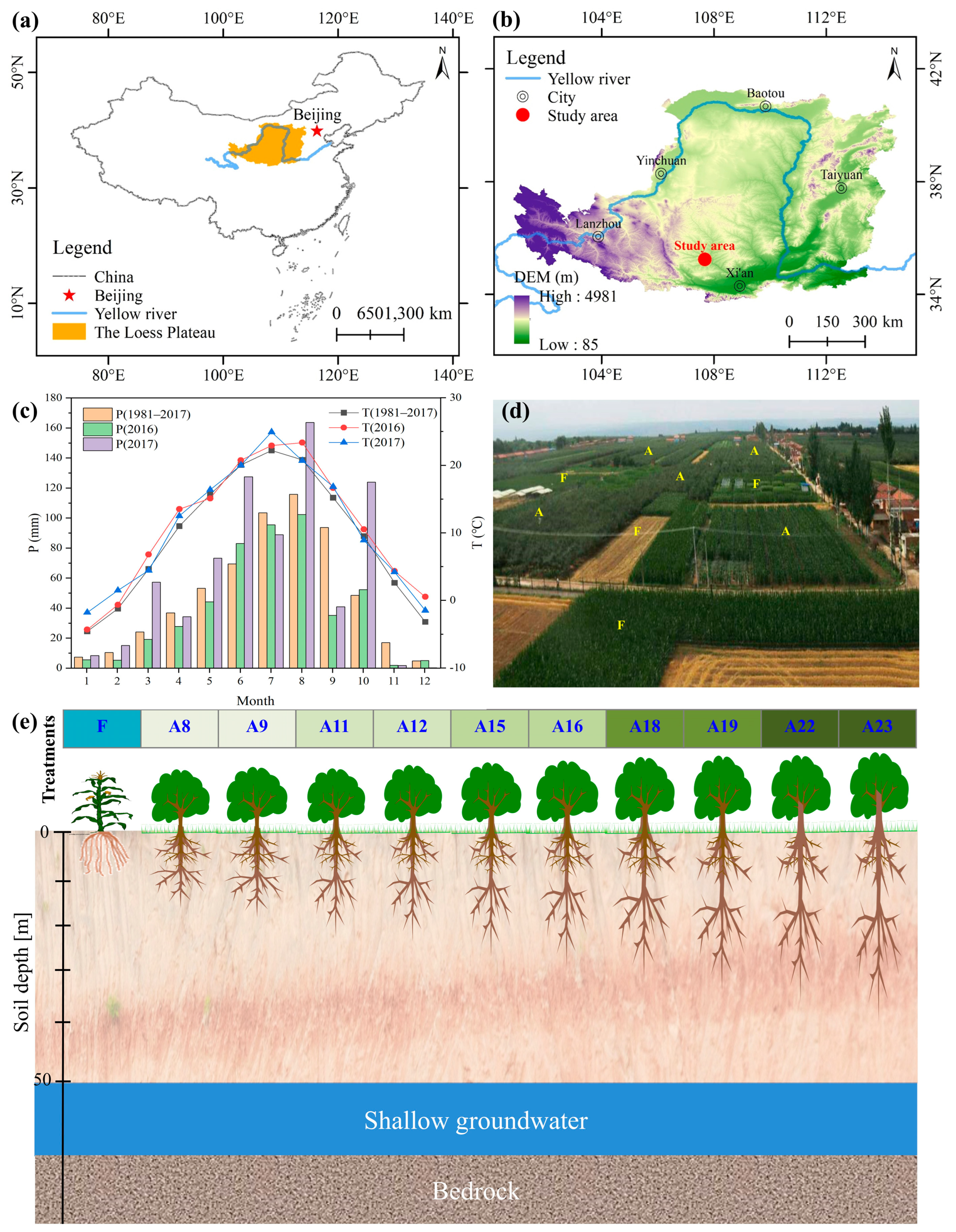
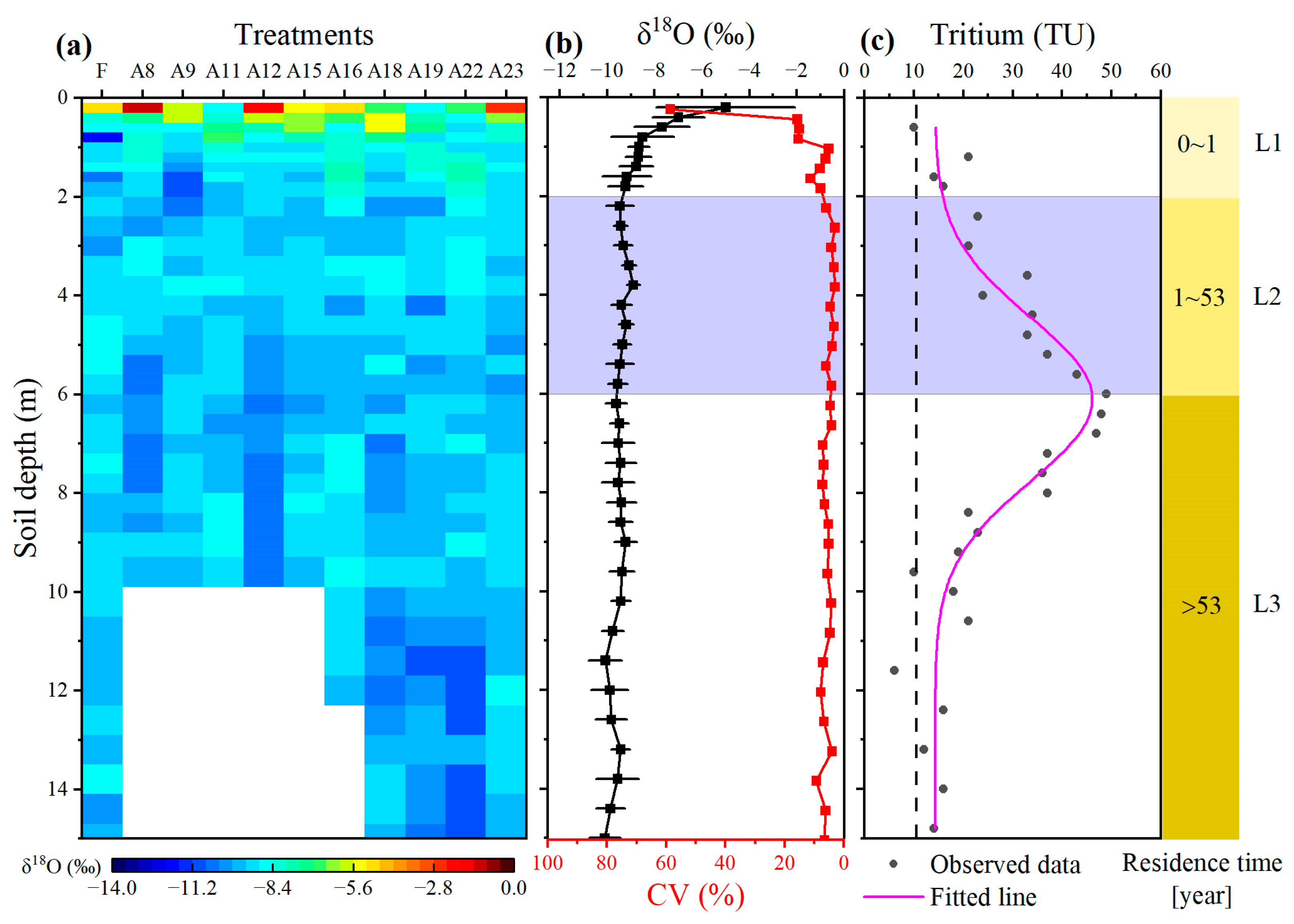

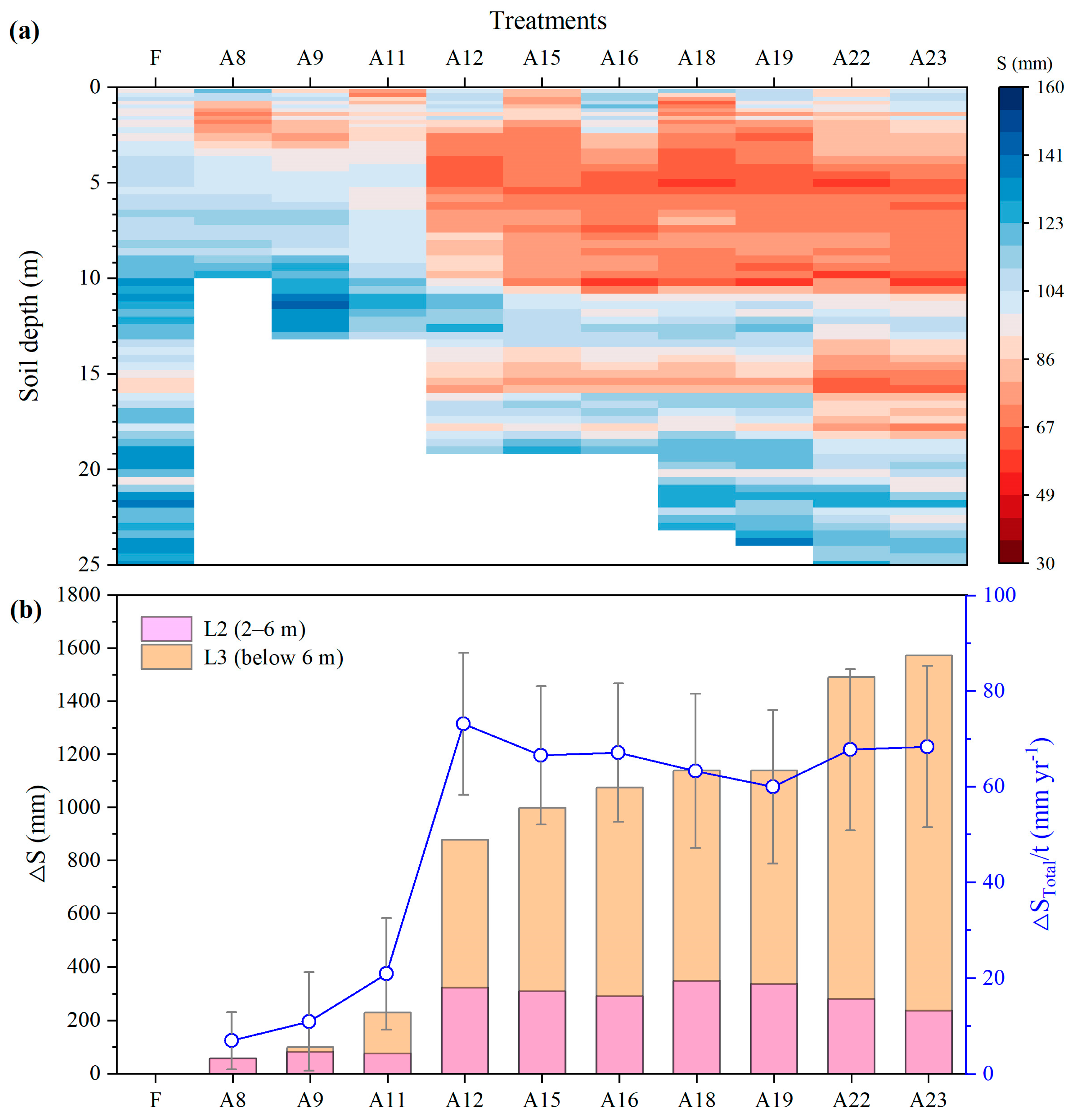
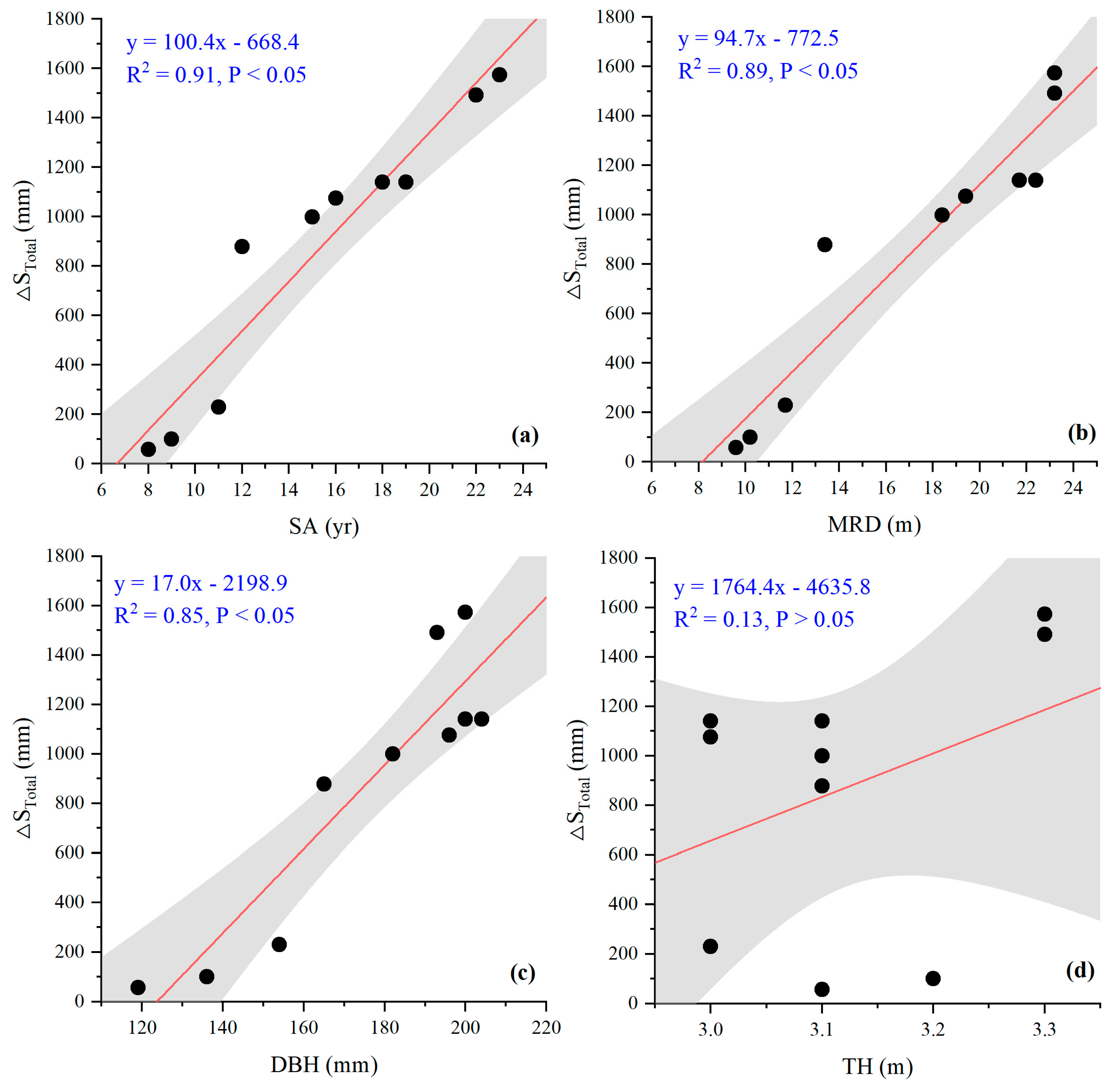
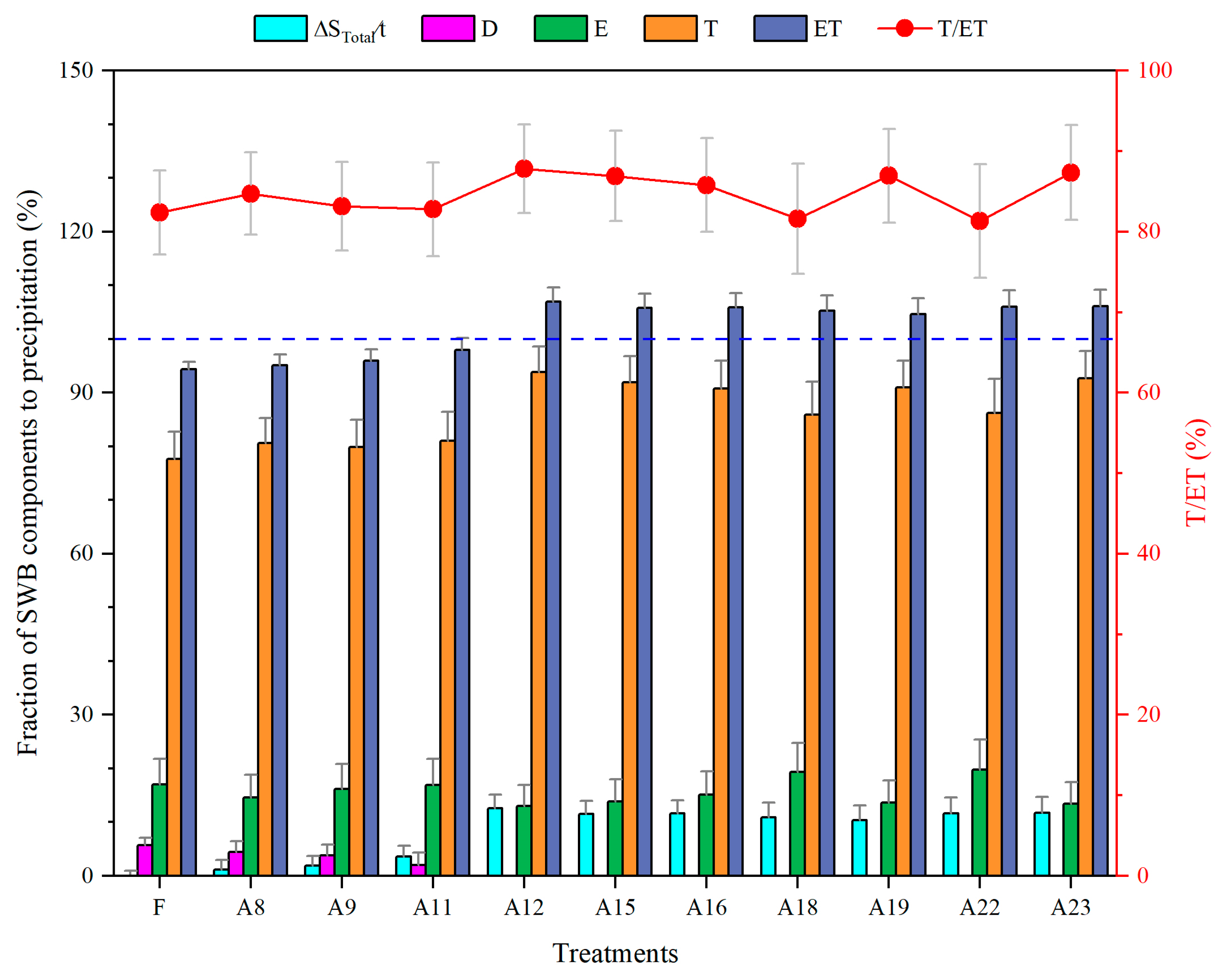
| Treatments | Land Use Types | Sampling Date | Soil Depth [m] | Clay [%] | Silt [%] | Sand [%] | SA [year] | TH [m] | DBH [mm] | MRD [m] | LAI [m2 m−2] |
|---|---|---|---|---|---|---|---|---|---|---|---|
| F | farmland | April 2017 | 25 | 19.1 (4.4) | 72.0 (4.3) | 8.9 (3.0) | - | - | - | - | - |
| A8 | apple orchard | July 2016 | 10 | 18.2 (3.5) | 71.6 (4.1) | 10.2 (4.0) | 8 | 3.1 (0.2) | 119 (8.7) | 9.6 (0.4) | 1.7 (0.7) |
| A9 | apple orchard | April 2017 | 13 | - | - | - | 9 | 3.2 | 136 | 10.2 | 1.6 (0.6) |
| A11 | apple orchard | July 2016 | 13 | 20.2 (4.8) | 70.0 (5.5) | 9.8 (3.2) | 11 | 3.0 (0.1) | 154 (11.9) | 11.7 (0.6) | 2.1 (0.8) |
| A12 | apple orchard | April 2017 | 19 | - | - | - | 12 | 3.1 | 165 | 13.4 | 2.1 (0.7) |
| A15 | apple orchard | July 2016 | 19 | 19.7 (4.6) | 70.7 (5.1) | 9.6 (2.6) | 15 | 3.1 (0.1) | 182 (13.9) | 18.4 (1.1) | 2.5 (0.7) |
| A16 | apple orchard | April 2017 | 19 | - | - | - | 16 | 3.0 | 196 | 19.4 | 2.5 (0.6) |
| A18 | apple orchard | July 2016 | 23 | 21.2 (4.4) | 69.9 (4.3) | 8.9 (2.4) | 18 | 3.0 (0.1) | 200 (15.4) | 21.7 (0.9) | 2.2 (0.5) |
| A19 | apple orchard | April 2017 | 24 | - | - | - | 19 | 3.1 | 204 | 22.4 | 2.1 (0.7) |
| A22 | apple orchard | July 2016 | 25 | 20.8 (4.1) | 70.0 (4.4) | 9.2 (2.7) | 22 | 3.3 (0.2) | 193 (16.8) | 23.2 (0.8) | 1.9 (0.5) |
| A23 | apple orchard | April 2017 | 25 | - | - | - | 23 | 3.3 | 200 | 23.2 | 1.9 (0.5) |
| Treatments | δ18O [‰] | lc-excess [‰] | ||||
|---|---|---|---|---|---|---|
| L1 | L2 | L3 | L1 | L2 | L3 | |
| F | −8.9 (1.9) | −9.1 (0.4) ab | −9.3 (0.4) | −2.6 (2.0) | −4.0 (0.6) bcd | −3.7 (1.2) |
| A8 | −7.7 (2.4) | −9.5 (0.6) cd | −10.1 (0.5) | −4.9 (3.2) | −3.4 (0.6) ab | −3.4 (1.2) |
| A9 | −8.9 (1.9) | −9.4 (0.4) bcd | −9.2 (0.2) | −4.5 (1.5) | −3.7 (0.5) ab | −3.5 (0.7) |
| A11 | −8.3 (0.8) | −9.1 (0.3) abc | −9.3 (0.5) | −2.1 (1.3) | −3.8 (1.0) abc | −3.2 (1.3) |
| A12 | −7.4 (3.2) | −9.6 (0.3) d | −10.4 (0.2) | −5.7 (4.5) | −3.1 (0.7) a | −1.9 (0.9) |
| A15 | −7.9 (1.6) | −9.4 (0.3) bcd | −9.3 (0.3) | −2.7 (0.9) | −3.3 (0.7) ab | −3.5 (0.9) |
| A16 | −7.6 (1.2) | −9.3 (0.4) bcd | −9.0 (0.4) | −3.3 (2.0) | −3.4 (0.4) ab | −4.7 (0.9) |
| A18 | −7.9 (1.7) | −9.3 (0.5) bcd | −9.8 (0.5) | −4.6 (2.4) | −4.6 (1.3) cd | −4.9 (1.6) |
| A19 | −8.4 (0.6) | −9.5 (0.6) d | −9.7 (0.5) | −2.7 (1.5) | −3.1 (1.5) a | −3.9 (1.3) |
| A22 | −8.2 (0.8) | −8.9 (0.4) a | −9.9 (0.8) | −1.8 (0.8) | −4.7 (1.1) d | −4.2 (1.5) |
| A23 | −7.7 (2.1) | −9.5 (0.3) cd | −9.3 (0.3) | −3.7 (2.5) | −3.1 (1.0) a | −5.0 (0.8) |
| ID | Locations | Methods | Land Use Types | P [mm year−1] | D [mm year−1] | E/P [%] | E/ET [%] | T/ET [%] | References |
|---|---|---|---|---|---|---|---|---|---|
| 1 | Changwu, China | Isotope & water balance | Farmland, apple | 581 | 0–33 | 13–20 | 13–19 | 82–87 | This study |
| 2 | Changwu, China | Isotope & HYDRUS | Farmland, apple | 581 | 1–10 | - | - | 64–74 | [30] |
| 3 | Changwu, China | Chloride mass balance | Farmland, apple | 581 | 3–58 | - | - | - | [19] |
| 4 | The Loess Plateau, China | Isotope | Farmland, grassland | 346–723 | - | 5–15 | - | - | [32] |
| 5 | Heihe, China | Water balance | Woodland | 105–114 | - | - | 20–27 | 73–80 | [50] |
| 6 | Luancheng, China | Isotope | Farmland | 480 | - | - | - | 60–80 | [51] |
| 7 | AZ, San Pedro River, USA | Water use efficiency | Woodland | 261 | - | - | 22–44 | 56–78 | [52] |
| 8 | Global | Meta-analysis | Farmland, orchard | - | - | - | 20–40 | 60–80 | [7] |
| 9 | Global | Meta-analysis | Natural forest, shrub | - | - | - | 10–35 | 65–90 | [7] |
| 10 | Global | Meta-analysis | Deciduous Forests | 234–896 | - | 9–36 | - | - | [48] |
Disclaimer/Publisher’s Note: The statements, opinions and data contained in all publications are solely those of the individual author(s) and contributor(s) and not of MDPI and/or the editor(s). MDPI and/or the editor(s) disclaim responsibility for any injury to people or property resulting from any ideas, methods, instructions or products referred to in the content. |
© 2024 by the authors. Licensee MDPI, Basel, Switzerland. This article is an open access article distributed under the terms and conditions of the Creative Commons Attribution (CC BY) license (https://creativecommons.org/licenses/by/4.0/).
Share and Cite
Xiang, W.; Si, B.; Li, H.; Li, M.; Song, J.; Tian, Y. Impacts of Deep-Rooted Apple Tree on Soil Water Balance in the Semi-Arid Loess Plateau, China. Forests 2024, 15, 930. https://doi.org/10.3390/f15060930
Xiang W, Si B, Li H, Li M, Song J, Tian Y. Impacts of Deep-Rooted Apple Tree on Soil Water Balance in the Semi-Arid Loess Plateau, China. Forests. 2024; 15(6):930. https://doi.org/10.3390/f15060930
Chicago/Turabian StyleXiang, Wei, Bingcheng Si, Huijie Li, Min Li, Jinxi Song, and Yulu Tian. 2024. "Impacts of Deep-Rooted Apple Tree on Soil Water Balance in the Semi-Arid Loess Plateau, China" Forests 15, no. 6: 930. https://doi.org/10.3390/f15060930
APA StyleXiang, W., Si, B., Li, H., Li, M., Song, J., & Tian, Y. (2024). Impacts of Deep-Rooted Apple Tree on Soil Water Balance in the Semi-Arid Loess Plateau, China. Forests, 15(6), 930. https://doi.org/10.3390/f15060930








